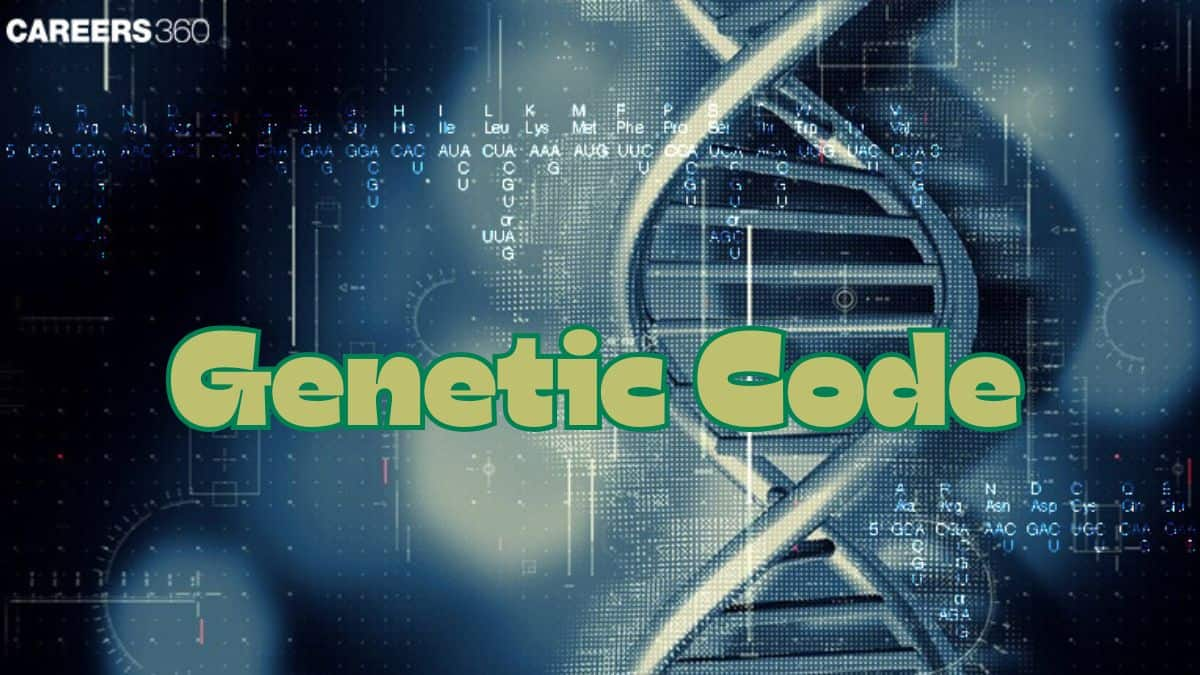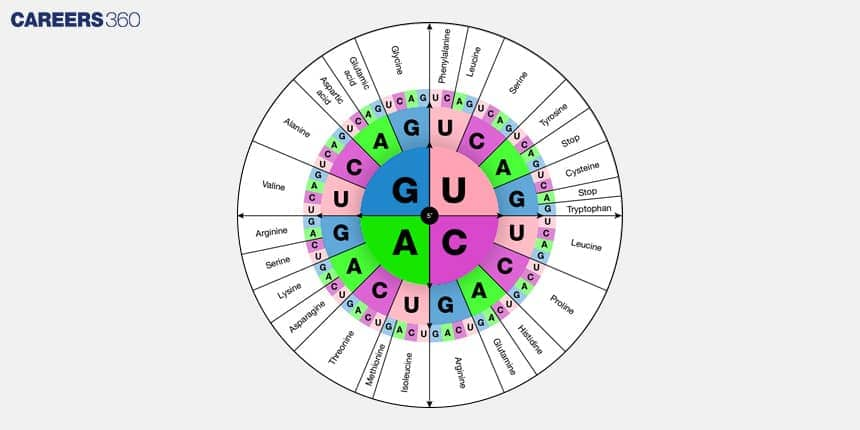Genetic Code: Definition, Steps, Types and Examples
The genetic code is the language of both DNA and RNA. This code is made from five nitrogenous bases. In DNA, it has A, T, G, and C, and in RNA, it has A, U, G, and C. The genetic code is read in triplets called codons. Each codon in DNA and RNA codes for one amino acid. This makes the genetic code the same in both DNA and RNA. The molecular basis of inheritance lies in the genetic code of DNA and RNA.
- What is a Genetic Code?
- Genetic Code Chart
- Genetic Code Discovery
- Characteristics of Genetic Code
- Properties of the Genetic Code
- Exceptions to the Genetic Code
- Applications of Knowing the Genetic Code
- Recommended Video for Genetic Code
- MCQ on Genetic Code

The genetic code is universal, redundant, and unambiguous, ensuring accurate protein synthesis. In this article, the genetic code, basic concepts of the genetic code, the transcription process, the process of translation, properties of the genetic code, and exceptions to the genetic code are discussed. Genetic code is a topic of the chapter Molecular Basis of Inheritance in Biology.
What is a Genetic Code?
The genetic code is a set of rules by which information that is encoded in the genetic material, either DNA or RNA sequences, is translated. It is translated into proteins by living cells. This language is universal in guiding the synthesis of proteins, the building blocks of life, from information contained in genes. The genetic code is known to be core to biology and heredity because it speaks about how the transfer of information from one generation to another takes place genetically. It promotes the structure and function of proteins.
Genetic Code Chart
The genetic code chart shows how RNA codons form proteins. The chart starts from the center with bases A, U, G, and C of RNA. Moving outward, three-letter codons are formed. Each codon codes for one amino acid. Some codons are start codons (AUG) and some are stop codons (UAA, UAG, UGA). This chart helps understand the genetic code, protein synthesis, and the molecular basis of inheritance.

Genetic Code Discovery
Decoding the genetic code is truly one of the milestones of molecular biology. It helped scientists understand how genetic information in DNA directs protein synthesis.
In 1953, Watson and Crick discovered the DNA double helix.
In 1961, Nirenberg and Matthaei found the first codon. Other scientists soon decoded the entire genetic code.
In 1962, Watson, Crick, and Wilkins got the Nobel Prize for the DNA structure.
In 1968, Nirenberg, Holley, and Khorana got the Nobel Prize for explaining the genetic code and protein synthesis.
Characteristics of Genetic Code
The genetic code is the language of life information. It tells cells how to make proteins. It is written in DNA and RNA sequences. Understanding codons, anticodons, and nucleotides explains how genes work. Some basic concepts are as follows:
DNA and RNA Basics
DNA is deoxyribonucleic acid, and RNA is ribonucleic acid. These are nucleic acids that store and transmit genetic information. DNA is a double-stranded molecule that acts as a long-term storage, whereas RNA is mostly single-stranded; it works both as a messenger and a functional molecule in protein synthesis.
Nucleotides and Bases
Nucleotides are the basic building blocks of nucleic acids. Each nucleotide is made up of a sugar, phosphate group, and nitrogenous base. For DNA bases, there are adenine (A), thymine (T), cytosine (C), and guanine (G). In RNA, uracil replaces thymine.
Codons and Anticodons
A codon is a series of three nucleotides in the mRNA that code for a specific amino acid or an amino acid termination signal during protein synthesis. The sequence complementary to the codon on the tRNA molecule--the anticodon--guarantees that the correct amino acid is brought into the sequence of the growing polypeptide chain.
Properties of the Genetic Code
The genetic code has special features. These help cells make the right proteins. It tells the cell how to read DNA and RNA. These rules work the same in almost all living things. The major properties of the genetic code are
Property | Description |
Triplet Code | 3 nucleotides form 1 codon for 1 amino acid. |
Universality | The same genetic code is used by almost all organisms. |
Degeneracy | Many codons can code for the same amino acid. |
Non- Overlapping | Codons are read one after another, without overlap. |
Commaless | No spaces or punctuation between codons. |
Polarity | Codons are read from 5' to 3' direction. |
Start Codon | AUG signals the start of protein synthesis. |
Stop Codon | UAG, UAA, UGA signal the end of protein synthesis. |
Exceptions to the Genetic Code
Since most genes in plants and microbes have comparable START and STOP signals and similar codons assigned to identical amino acids, the genetic code is universal. Assigning one or two of the STOP codons to an amino acid is one of the few exceptions that have been found.
In addition, even though GUG is designed for valine, both AUG and GUG may code for methionine as a beginning codon. This violates the non-ambiguousness property. As a result, it can be claimed that few codes frequently deviate from universal or unambiguous codes.
Applications of Knowing the Genetic Code
Advances in understanding the genetic code have prompted radical technologies like CRISPR, which enables very high-precision editing of genes. This makes several applications possible within agriculture—in GMOs—and medicine for the creation of new treatments, but more generally in industry, notably for the production of biofuels and bioplastics.
Medical and Clinical Studies
The knowledge of the genetic code plays a vital role in comprehending genetic diseases and designing gene therapies. Gene therapy is essentially treating or preventing diseases by correcting a gene when it is malfunctioning. It gives hope for some disease conditions that are incurable at present.
Recommended Video for Genetic Code
MCQ on Genetic Code
Question: Directions: In the following questions, a statement of Assertion (A) is followed by a statement of reason (R).
Assertion: Genetic codons are degenerate.
Reason: One amino acid can be coded by more than one genetic code.
Mark the correct choice as
If both assertion and reason are true and the reason is the correct explanation of the assertion,
If both assertion and reason are true but the reason is not the correct explanation of the assertion
If the assertion is true but the reason is false
If both assertion and reason are false
Answer: Some amino acids are coded by more than one codon; hence, the code is degenerate.
The total number of codons coding for amino acids is 61. 61 types of codon codes for 20 amino acids. It suggests that one amino acid can have more than one genetic code. This property is considered the degeneracy of codons.
Hence, the correct option is 1) If both the assertion and the reason are true and the reason is the correct explanation of the assertion.
Question: Which of the following statements are correct about genetic code?
I. It contains 65 codons
II. AUG codes for methionine amino acid
III. The same amino acid is coded for by the multiple codons.
IV. Genetic codon codes for mRNA
I and II
I and III
II and III
III and IV
Answer: The genetic codon contains 63 codons and one stop codon. The Methionine acts as an initiation codon code by the AUG genetic code. The same amino acid is coded for by the various codons. The genetic code does not code for mRNA
Hence, the correct answer is option 3) II and III.
Question: George Gamow proposed that the genetic code should be made up of three nucleotides to code for 5 amino acids. Considering there are four bases, how many possible codons would be generated using this three-nucleotide code?
64 codons
27 codons
81 codons
125 codons
Answer: According to the given information, George Gamow suggested that the genetic code should be composed of three nucleotides to code for 5 amino acids. Since there are four bases (A, C, G, and T), we need to calculate the number of possible codons that can be formed using three nucleotides.
The number of possible codons can be determined by calculating the total number of combinations using the four bases raised to the power of three (4 × 4 × 4).
Calculating this expression: 4 × 4 × 4 = 64
Therefore, using a three-nucleotide code, 64 codons would be generated.
However, since we only need to code for 5 amino acids, the actual number of codons required would be less than the maximum number of codons that can be generated.
Hence, the correct answer is Option 1)64 codons.
Also Read-
Frequently Asked Questions (FAQs)
The genetic code denotes a set of rules whereby translation from DNA or RNA sequences occurs into proteins. Proteins are essential for all biological functions and operations, and thus their synthesis is crucial.
A codon is a three-nucleotide-segment sequence of mRNA specifying an amino acid. A corresponding complementary three-nucleotide segment on tRNA pairing with the codon during translation is called the anticodon.
A codon is a sequence of three nucleotides in mRNA that specifies a particular amino acid or stop signal. An anticodon is a complementary sequence of three nucleotides on a tRNA molecule that pairs with a codon during protein synthesis.
The mutation changes the DNA sequence, and this change of sequence can result in an effect on the genetic code. It can affect the structure and function of proteins, including some diseases; other mutations, however, make no difference.
These involve gene editing technologies like CRISPR, the development of gene therapies, the production of genetically modified organisms, pharmaceuticals, and industrial biotechnology.
The genetic code is crucial to the central dogma as it provides the rules for translating the information in DNA (via mRNA) into proteins. It forms the basis for the flow of genetic information from DNA to RNA to proteins.
The comma-less nature of the genetic code means there are no specific punctuation marks or spacers between codons. This property allows for continuous reading of the genetic message and efficient use of genetic material.
Also Read
24 Jul'25 06:47 PM
24 Jul'25 12:41 PM
24 Jul'25 12:14 PM
24 Jul'25 11:56 AM
24 Jul'25 11:33 AM
24 Jul'25 11:16 AM
23 Jul'25 07:16 PM
23 Jul'25 07:08 PM
23 Jul'25 07:01 PM
